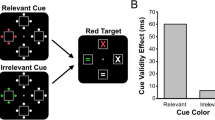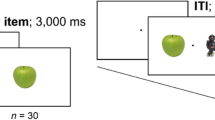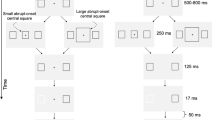Abstract
Automatic attentional capture by a salient distractor can be prevented by spatial attentional control settings (ACSs) (e.g., Yantis and Jonides in J Exp Psychol Hum Percept Perform 16:121–134, 1990). Earlier, converging evidence for a spatial ACS (Eason et al. 1969) was found in event-related potentials (ERPs). In these studies, the ACS was defined by a single target-relevant location. In an extension, Ishigami et al. (Vis Cogn 17:431–456, 2009) demonstrated a successful ACS in performance that was based on multiple (two) target-relevant locations. The purpose of the current study is to seek converging evidence from ERPs for a spatial ACS defined by multiple (two) target-relevant locations, using the methods in Ishigami et al. (Vis Cogn 17:431–456, 2009). Any one of four figure-8s brightened uninformatively (cue) before presentation of a digit target calling for a speeded identification (2 or 5). A spatial ACS was encouraged because in different blocks, the digit targets appeared only on the horizontal or vertical axis. Performance was more impaired following the invalid-attended cues than following invalid-unattended cues, consistent with Ishigami et al. (Vis Cogn 17:431–456, 2009) and verifying a successful spatial ACS. The direction of attention significantly affected the visual evoked potentials (VEPs) elicited by otherwise identical cues: the amplitudes of early VEPs were greater when the location the cue was presented in was target-relevant than when the location was target-irrelevant. These results re-affirm that attentional capture by irrelevant salient stimuli can be modulated by spatial ACSs defined by multiple target locations in performance and provide converging evidence from ERPs for the previously established behavioral findings.


Similar content being viewed by others
Notes
In this study, the pop-out stimulus was called a “target,” even though there was a stimulus (circle) which was to be responded to in parts 1 and 3.
In part 1, the pop-out stimulus was not attended (participants were not informed about the presence of the pop-out stimulus), and therefore, it was not relevant. In part 3, the pop-out stimulus could be attended (participants were informed about the presence of the pop-out stimulus) and therefore was relevant.
Although our interpretation of the flexibility of endogenous attention is that of an unsplittable beam whose size and shape might be controlled (cf, McCormick and Klein 1990; McCormick et al. 1998), it is important to note that Ishigami et al. did not test the space between the two target locations. Consequently, we cannot know whether the ACS established in that study (or in the present one which used similar methods) was a single ellipse that encompassed the two possible target locations or two attended regions separated by inattention. Distinguishing between these was not our goal (for those who are interested in such studies, see Malinowski et al. 2007; Müller et al. 2003). Rather, we were interested in whether participants could establish an ACS that included 2 regions of space on opposite sides of fixation while excluding other regions of space.
Demographic information of one participant was lost.
Due to hardware problems with the EOG electrodes during data acquisition, we used frontal electrodes (AF7–8), as suggested by an anonymous reviewer, to provide evidence whether our participants were following instructions and remaining fixated during the cues (particularly during the 150–220 ms post-cue time range from which the critical P1 data were derived). In a different experiment (Satel et al. 2012), participants were instructed to foveate a peripheral cue or remain fixated during the cue. In that study, we recorded EEG while also using eye monitoring (EyeLink 1000) technology to determine whether the instructions were followed. In the 150–220 ms range in that experiment, the AF7–8 electrodes were picking up between 15 and 25 µV of eye movement-related activity when an eye movement was executed. In the present experiment, the amplitudes of "simulated hEOG" remained within 1 µV regardless of the cue location (left and right) and attention condition (attended and unattended), suggesting that our participants were following instructions and rarely making eye movements toward the uninformative peripheral cues.
Baselining the data to the first 50 ms post-stimulus, the VEP elicited by the unattended cue was still marginally smaller than VEP elicited by attended cue, t(22) = 1.77, p = .09.
Baselining the data to the first 50 ms post-stimulus, the VEP elicited by the unattended cue was marginally smaller than VEP elicited by attended cue, t(22) = 1.90, p = .07. When repeating this analysis collapsing across the ACS, the VEP elicited by the unattended cue was significantly smaller than VEP elicited by attended cue, t(22) = 2.12, p < .05.
References
Eason RG (1981) Visual evoked-potential correlates of early neural filtering during selective attention. Bull Psychon Soc 18:203–206
Eason RG, Harter MR, White CT (1969) Effects of attention and arousal on visually evoked cortical potentials and reaction time in man. Physiol Behav 4:283–289
Eimer M, Kiss M (2008) Involuntary attentional capture is determined by task set: evidence from event-related brain potentials. J Cogn Neurosci 20:1423–1433
Folk CL, Remington R (1998) Selectivity in distraction by irrelevant featural singletons: evidence for two forms of attentional capture. J Exp Psychol Hum Percept Perform 24:847–858
Folk CL, Remington RW, Johnston JC (1992) Involuntary covert orienting is contingent on attentional control settings. J Exp Psychol Hum Percept Perform 18:1030–1044
Heinze HJ, Luck SJ, Mangun GR, Hillyard SA (1990) Visual event-related potentials index focused attention within bilateral stimulus arrays. I. Evidence for early selection. Electroencephalogr Clin Neurophysiolm 75:511–527
Hillyard SA, Münte TF (1984) Selective attention to color and location—an analysis with event-related brain potentials. Percept Psychophys 36:185–198
Ishigami Y, Klein RM, Christie J (2009) Exploring the modulation of attentional capture by attentional control settings using performance and illusory line motion. Vis Cogn 17:431–456
Johannes S, Münte TF, Heinze HJ, Mangun GR (1995) Luminance and spatial attention effects on early visual processing. Cogn Brain Res 2:189–205
Juola JF, Koshino H, Warner CB (1995) Tradeoffs between attentional effects of spatial cues and abrupt onsets. Percept Psychophys 57:333–342
Klein R (2009) On the control of attention. Can J Exp Psychol-Rev Can Psychol Exp 63:240–252
Malinowski P, Fuchs S, Müller MM (2007) Sustained division of spatial attention to multiple locations within one hemifield. Neurosci Lett 414:65–70
McCormick PA, Klein R (1990) The spatial distribution of attention during covert visual orienting. Acta Psychol 75:225–242
McCormick PA, Klein RM, Johnston S (1998) Splitting versus sharing focal attention: comment on Castiello and Umiltà (1992). J Exp Psycho Hum Percept Perform 24:350–357
Müller MM, Malinowski P, Gruber T, Hillyard SA (2003) Sustained division of the attentional spotlight. Nature 424:309–312
Posner MI (1980) Orienting of attention. Q J Exp Psychol 32:3–25
Satel J, Hilchey MD, Wang Z, Story R, Klein RM (2012) The effects of ignored versus foveated cues upon inhibition of return: an event-related potential study. Atten Percept Psychophys (in press)
Schubö A, Schröger E, Meinecke C, Müller HJ (2007) Attentional resources and pop-out detection in search displays. NeuroReport 18:1589–1593
Theeuwes J (1991) Exogenous and endogenous control of attention: the effect of visual onsets and offsets. Percept Psychophys 49:83–90
Yantis S, Jonides J (1990) Abrupt visual onsets and selective attention: voluntary versus automatic allocation. J Exp Psychol Hum Percept Perform 16:121–134
Acknowledgments
This research was made possible by a Natural Sciences and Engineering Research Council Discovery Grant to RK and scholarship support to YI from the Killam Trust and Multiple Sclerosis Society of Canada. We express thanks to John Christie for his technical support.
Author information
Authors and Affiliations
Corresponding author
Appendix
Appendix
See Fig. 3 for topographical plots of activity during the period of cue-elicited P1 analysis when a horizontal ACS is active.
Topographical activity plots for the cues presented on the horizontal axis averaged over the time period used for P1 analyses (145–205 ms post-cue). Topographical activities based on all the right cues (a), the difference between attended and unattended right cues (b), all the left cues (c), and the difference between attended and unattended left cues (d)
Rights and permissions
About this article
Cite this article
Ishigami, Y., Hamm, J.P., Satel, J. et al. Exploring the modulation of attentional capture by spatial attentional control settings: converging evidence from event-related potentials. Exp Brain Res 223, 525–532 (2012). https://doi.org/10.1007/s00221-012-3279-1
Received:
Accepted:
Published:
Issue Date:
DOI: https://doi.org/10.1007/s00221-012-3279-1





